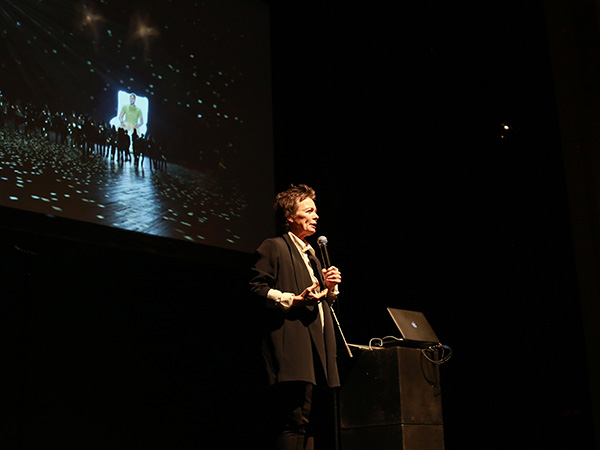Laurie Anderson Talks Collaboration, Failure, and “Dangerous Art”

Multimedia artist Laurie Anderson began her talk before a crowd of Emerson College graduate students and others gathered at the Paramount Mainstage on March 25 by telling them, “Most of the work I do begins with a kind of failure.”
She then laid out the 18-year genesis of last fall’s Habeas Corpus, her four-day installation at the Park Avenue Armory in New York City. It was a succession of failures, radical reimaginings, and most importantly, collaborations.
Anderson was the keynote speaker capping off the daylong New England Graduate Media Symposium, “Assembling Bodies: Exchanges in Collaboration,” which featured panels centered around sharing ideas in the artistic process. It was organized by Anto Astudillo and Kimberly Forero-Arnias, MFA students in the Visual and Media Arts Department.
Habeas Corpus had its seeds in 1997, in a small church-turned-community center in Austria, when Anderson decided she would build a life-sized sculpture of a prisoner in the apse of the church, onto which she would project a live feed of the prisoner.
“[He would be] there, but not there,” Anderson said of the prisoner.
The installation didn’t happen for legal reasons, and later, a similar attempt at the old Whitney Museum in New York with an inmate from Sing Sing also fell through, because it was too political, she said. The following year in Milan, Anderson was able to pull off Dal Vivo with the help of a convicted bank robber in San Vittore Prison.
But she really wanted to do it in the United States. The exhibit’s next incarnation was going to involve 12 statues inside the Park Avenue Armory, with feeds from a dozen New York prisons beamed onto them. When the Department of Homeland Security told her that her project would never happen in the United States, Anderson said she had almost lost hope.
Then last year, through a London agency, she was able to find a collaborator who would alter her vision and bring it to life.
Mohammed el Gharani, a Chadian raised in Saudi Arabia, was captured at 14, accused of being connected to a London terrorist cell. He was sent to Guantanamo Bay, where he was brutally tortured by U.S. government agents for seven years. He was released due to lack of evidence in 2009. He currently lives in West Africa.
In Habeas Corpus, el Gharani’s live image was projected onto a statue several times larger than life-size, so that it resembled the Lincoln Memorial. A mirror ball filled the darkened room with whirling “stars.”
While researching el Gharani’s story and Guantanamo for the installation, Anderson said she became “fascinated” by the U.S. government’s version of el Gharani’s story versus his own. In reading the legal documents associated with his case, she was struck by how everything hinges on language—how by saying he is a non-person, they are saying they are free to torture, that he has no body.
El Gharani and Anderson not only collaborated on the four-day exhibit, but they also visited slave castles on the West coast of Africa together and wrote about the experience. El Gharani’s path, from Chad to Saudi Arabia to the Caribbean, was the same as the slaves’ path 500 years ago, Anderson said.
“I couldn’t imagine that the collaborator I found would be such a wonderful writer,” she said.
“We actually just won an award [Yoko Ono’s 2016 Courage Award for the Arts for Habeas Corpus],” Anderson said. “[El Gharani] said, ‘This is the first time I have another word in front of my name, because I’ve always been known as a terrorist or detainee. This is the first time in the press I was known as a collaborator.”
During the exhibit, Anderson said, el Gharani was able to see the visitors to Habeas Corpus via a camera trained on the sculpture (he couldn’t hear them), and he and the visitors would interact. Some of the Americans would mouth apologies to el Gharani for what their government did to him, she said.
One audience member on Friday told Anderson she felt like that “looking for absolution” was a “performance of humility” on the part of the Americans, which allows us to maintain our dominance over other cultures.
Anderson denied that anyone was absolved in the process.
“War has a way of shaking a lot of things up, and making us go, ‘Who are we and what are we doing?’” she said. “It’s not ‘fine’ what we’re doing. I don’t feel fine about it…I feel better about it because I was able to get information and share information with people.”
When asked if she ever feels “pushback” from people for working in so many different genres, Anderson, who has done music, film, sculpture, video art, performance art, and more, said she tells people she’s a “multimedia artist—which is stupid, because we’re all multimedia artists.
“I think it’s one of the things that always irritates me about some of the …art world. Pretty soon the art police come along and you get a big ticket. ‘Get back in your lane! Get making the thing you’re known for,’” she said.
An audience member asked Anderson if she’s inspired by technology. She said it can be a great tool and fun to play with, and like everyone, she has a love/hate relationship with it.
“I don’t think technology makes anything more interesting or beautiful or whatever,” she said. “I think you can make very dangerous art with a pencil.”
Categories